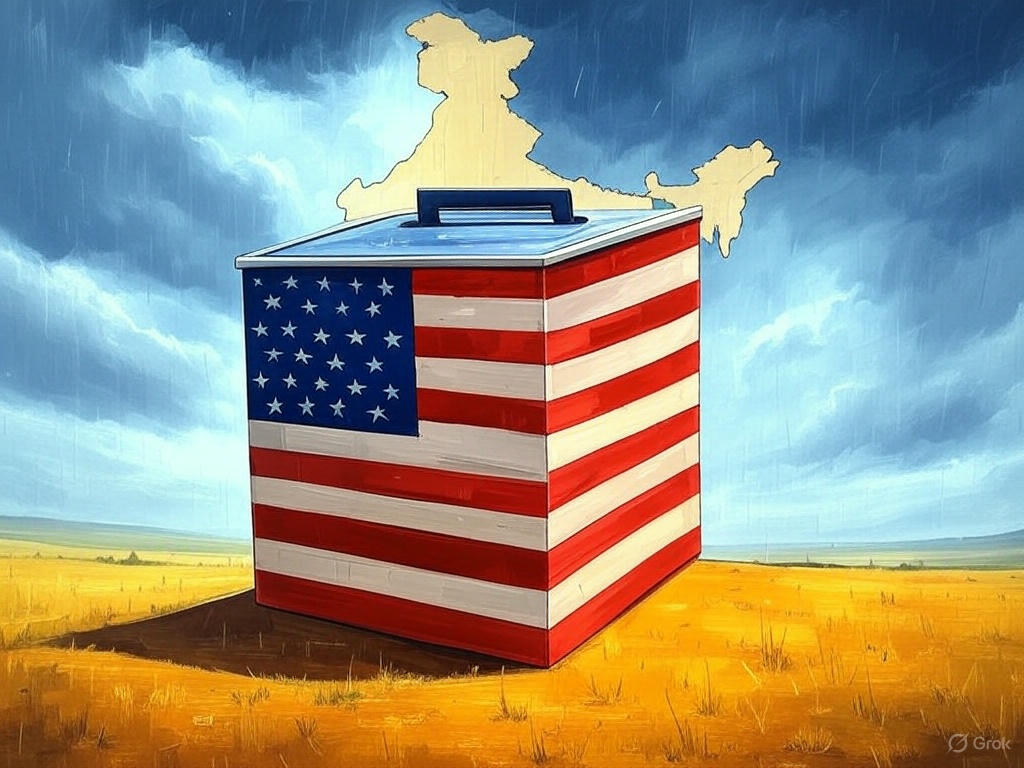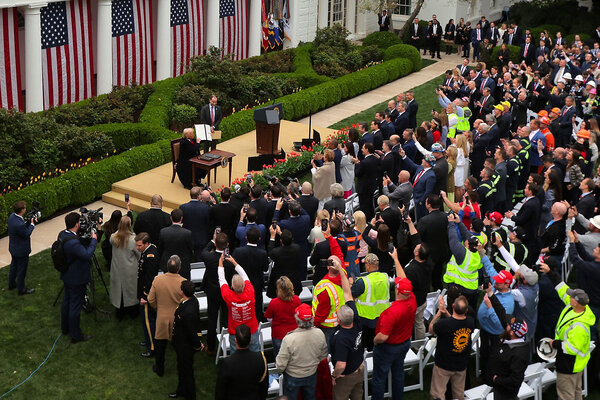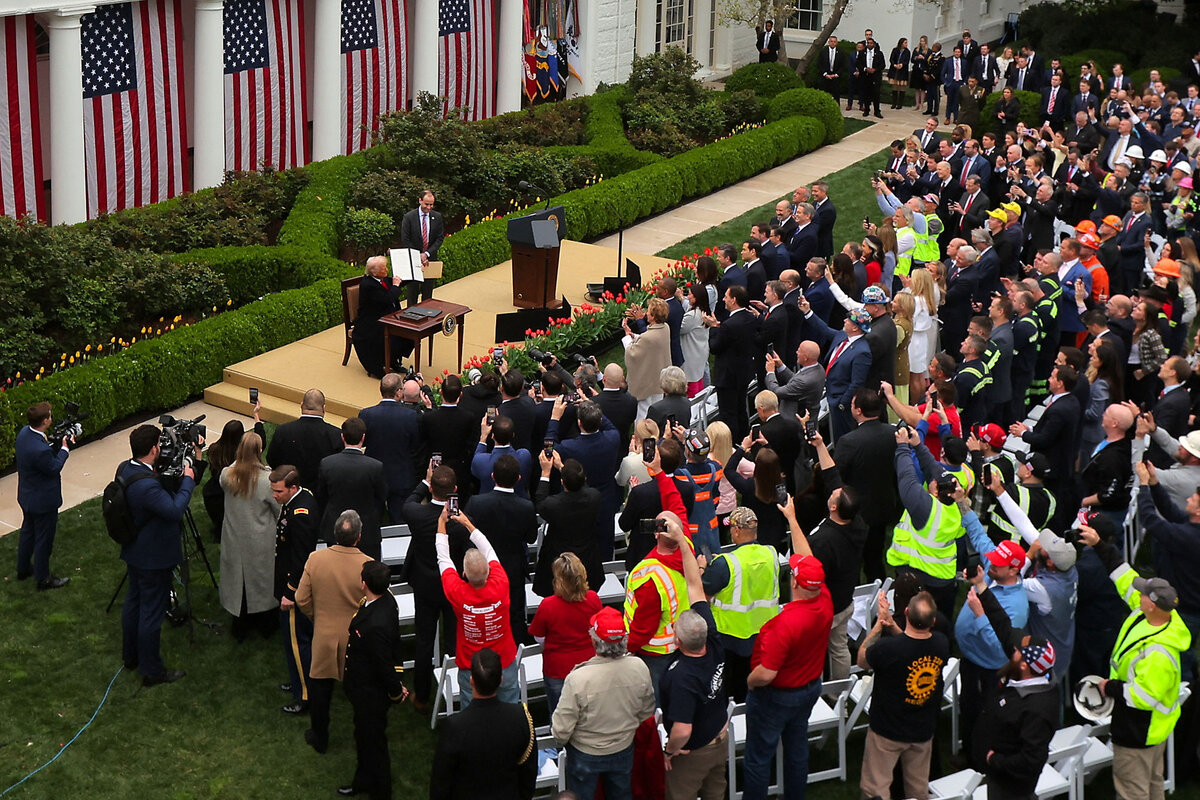World
Trump Signs Executive Order to Overhaul U.S. Elections, Cites India’s Voter ID System as Inspiration
March 25, 2025, The United States is buzzing with news that could reshape how Americans cast their votes. President Donald Trump has just put pen to paper on a sweeping executive order aimed at tightening up federal elections—and he’s pointing to India as a shining example. According to a report from ANI News, Trump’s latest […]

March 25, 2025, The United States is buzzing with news that could reshape how Americans cast their votes. President Donald Trump has just put pen to paper on a sweeping executive order aimed at tightening up federal elections—and he’s pointing to India as a shining example. According to a report from ANI News, Trump’s latest move mandates proof of citizenship for voter registration and sets strict deadlines for mail-in ballots, sparking both applause and outrage across the nation.
A Bold Step for “Election Protections”
Picture this: a crowded polling station, voters clutching IDs, and election officials double-checking citizenship papers. That’s the vision Trump laid out when he signed the order on Tuesday, claiming the U.S. has “failed to enforce basic and necessary election protections.” It’s a line that hits home for his supporters, who’ve long argued the system’s too lax. But what’s raising eyebrows is his nod to India—a country he says has nailed voter identification with biometric databases and strict ID checks.
India’s system isn’t perfect, but it’s hard to deny its scale. With over 900 million registered voters, the country uses fingerprint scans and voter ID cards to keep things legit. Trump’s order doesn’t go that far—yet—but it’s clear he’s inspired. “India and Brazil are tying voter identification to a bio-metric database,” the order reads, hinting at a future where tech could play a bigger role stateside. For now, though, the focus is on paper proof: passports, birth certificates, or other documents to confirm you’re a U.S. citizen before you can vote.
What’s Changing—and Why It Matters
So, what’s actually in this order? For starters, anyone registering for federal elections will need to show they’re a citizen—no more self-attestation, where you just swear it’s true. States will also have to team up with federal agencies like Homeland Security to cross-check voter rolls and sniff out non-citizens. And those mail-in ballots? They’ve got to be in by Election Day—no late arrivals allowed. States that don’t play ball could see their federal funding slashed, a threat that’s already got governors sweating.
Trump says it’s all about trust. “We’re making elections secure again,” he declared on Truth Social, calling it one of the “farthest-reaching” actions of his presidency. His base is cheering—many still believe the 2020 election was riddled with fraud, despite no hard evidence. But critics? They’re fuming. They argue this could kick millions of eligible voters—especially minorities and low-income folks who might not have easy access to IDs—right off the rolls.
India’s Example: A Model or a Mirage?
Let’s talk about that India shoutout. Over there, every voter gets a card with a unique number tied to their biometric data—think fingerprints or iris scans. It’s a massive operation, and it’s helped cut down on fraud in a country where elections are a logistical marathon. Trump’s clearly impressed, and he’s not alone—some experts say the U.S. could learn a thing or two. But here’s the rub: India’s system took years and billions to build. The U.S., with its patchwork of state-run elections, isn’t exactly set up for a quick copy-paste.
Plus, not everyone’s sold on the idea. “India’s context is different—rural voters, literacy challenges,” one election analyst told me. “Forcing that model here could backfire, leaving people who’ve voted for years suddenly shut out.” It’s a fair point—America’s not India, and what works in Delhi might flop in Detroit.
The Fight Ahead
This order’s barely dry, and the battle lines are already drawn. Legal challenges are a sure bet—Colorado’s secretary of state has already called it “unlawful,” hinting at a courtroom showdown. Democrats say it’s voter suppression dressed up as reform; Republicans counter it’s common sense to keep elections honest. Meanwhile, everyday Americans are left wondering: will this make voting safer—or just harder?
For folks like you and me, it’s a mixed bag. If you’ve got your passport handy, no big deal. But if you’re scrambling to dig up old records—or if you’re in a state that drags its feet—this could feel like a punch to the gut. And with midterms looming in 2026, the clock’s ticking to see how this plays out.
What’s Next?
Trump’s not waiting for Congress—he’s sidestepped them entirely, bypassing stalled bills like the SAVE Act that pushed similar ideas. It’s a power move, no doubt, and it’s got people talking about just how far a president can stretch executive authority. Will it stick? That’s for the courts to decide. For now, the U.S. election system’s in for a shake-up—and India’s unexpectedly along for the ride.
World
Barack Obama says ‘sorry’ for photobombing; family says they got an heirloom picture
A Washington family got a pleasant surprise when Barack Obama entered the frame of their family photo. Former president Barack Obama said sorry for unintentionally photobombing what an overjoyed family claimed will now go down into their family heirloom. One Portia Moore posted the photo of her kids with Barack Obama passing by in the […]

Former president Barack Obama said sorry for unintentionally photobombing what an overjoyed family claimed will now go down into their family heirloom. One Portia Moore posted the photo of her kids with Barack Obama passing by in the background. “Preston and Belle, I hope you enjoyed peak bloom! My bad for stepping into the shot,” Barack Obama commented in the now viral photo.
The viral photo was part of Portia’s family photo shoot for Cherry Blossom. “It’s the kids turn to take a photo together and Damien is saying something to me. I’m just focused on Preston not running towards the water (peak mom moment). After that shoot was done I pick Preston up and asked Damien “what were you saying”? He goes “that was President Obama who just walked by” and looks his direction. I was like whaaaaat?! I ran to the photographer and asked her if she got the picture. She scrolls through and BOOM there is it! The perfect shot!” Portia described how the photobombing unfolded.
“This story is one to remember and the picture is a family heirloom (literally). And nope, we did not bother him on his much needed peaceful stroll,” the caption read.
Briana Inell, the photographer, told the New York Times that she did not even notice that Barack Obama entered the frame as she was focusing on the blossoms on the right and the Washington Monument on the left.
It was 7.30 in the morning and Obama probably went out to take a morning stroll at the Tidal Basin, a reservoir between the National Mall and the Potomac River. “It’s fun to be able to play tourist once in a while,” Mr. Obama said on Instagram later on Monday. “The cherry blossoms were beautiful this morning!”
“In the act of it, or as it transpired, you’re not realizing because you don’t even think that you’re going to see President Obama, right?” Belle and Preston’s father Damien Thomas said. “So you don’t put two and two together until after the fact and you realize, OK, that really is President Obama.”
World
Trump Ignites a Groundbreaking Global Trade Battle
On April 3, 2025, former President Donald Trump rolled out an ambitious set of tariffs, shaking up both domestic and global trade landscapes. Announced with his signature flair, these measures signal a aggressive push to reshape America’s economic relationships as he gears up for his next chapter in leadership. It’s a move that’s got everyone—from […]

On April 3, 2025, former President Donald Trump rolled out an ambitious set of tariffs, shaking up both domestic and global trade landscapes. Announced with his signature flair, these measures signal a aggressive push to reshape America’s economic relationships as he gears up for his next chapter in leadership. It’s a move that’s got everyone—from everyday shoppers to international leaders—paying close attention.
Trump’s latest tariff strategy isn’t holding back. He’s slapped a hefty 25% tariff on goods coming from countries outside the U.S. free trade agreements, but there’s a twist: Canada and Mexico, two of America’s biggest trading buddies, dodged the steepest hikes. Instead, they’ll stick with an earlier 25% rate on items not covered by existing deals. Meanwhile, other nations face what Trump calls “reciprocal” tariffs—higher rates designed to mirror what they charge U.S. goods. It’s a tit-for-tat approach aimed at leveling the playing field.
The timing couldn’t be more telling. Earlier that same day, the National Retail Federation (NRF) dropped its 2025 sales forecast, predicting a modest growth of 2.7% to 3.7%, landing between $5.42 trillion and $5.48 trillion. That’s a slight dip from last year’s 3.6% jump, hinting at a cautious outlook for retail. With Trump’s tariffs now in the mix, questions are swirling about how these new costs might ripple through stores and hit consumers’ wallets.
This isn’t just policy wonk stuff—it’s personal. Higher tariffs could mean pricier goods on shelves, especially for imports that don’t get a pass. But Trump’s betting big that protecting American industries will spark a homegrown economic boom. Whether that gamble pays off is the million-dollar question, and it’s one we’ll all be watching unfold as his administration takes shape.
World
Some collateral damage with disruption? In Trump 2.0, that’s OK.
During Mr. Trump’s first term, he also frequently complained that some officials in his own administration opposed or slow-walked his directives. This time, he has a more loyal team.policy that until recently would have been anathema to most mainstream Republicans, as a drag on growth and investment.

While tariffs raise questions about economic risk-taking, Mr. Trump’s administration has also shown incaution in other areas. National security adviser Mike Waltz’s use of Signal, an unsecure app, for a group chat about a U.S. bombing mission in Yemen raised questions about competence. Mr. Trump defended Mr. Waltz and others on the chat, including Vice President JD Vance, which inadvertently included the editor of The Atlantic. (Mr. Waltz also reportedly used his personal Gmail account for other weapons-related communications.) DOGE’s approach, which has already drawn a flood of litigation, may yield only modest fiscal savings. But the greater impact won’t be known until sometime in the future, when hollowed-out agencies try to respond to a crisis, says Martin Gilens, a professor of public policy at UCLA. “A lot of the consequences will be slow to develop,” he says. Republicans have argued that states’ capacity to respond to crises should be bolstered so they’re not as reliant on federal agencies.Mr. Musk has bluntly said his team “will make mistakes. We won’t be perfect,” he told Fox Business. “But when we do make mistakes, we will fix it very quickly.” Mr. Trump told Fox in March that he couldn’t rule out a recession this year as a result of his tariffs. “There is a period of transition because what we’re doing is very big. We’re bringing wealth back to America. … It takes a little time, but I think it should be great for us.” Similarly, Commerce Secretary Howard Lutnick, when asked by CBS News about a possible tariff-induced recession, said “it’s worth it” to achieve the president’s goals.
Why We Wrote This
Still, voters also hold a dim view of how Democrats govern. President Joe Biden’s ratings never recovered from the chaotic exit from Afghanistan in his first year in office.
Unlike in Mr. Trump’s first term, when an inexperienced administration didn’t notch many significant achievements, his second term is likely to yield bigger wins, at least in the year and a half before next year’s midterms. But the administration’s successes may seed its own downfall, says Professor Gilens. “This time it seems like the problems that they’re going to face are not being unable to do what they want, but rather the problems that result from doing what they want.”The Senate voted Wednesday to narrowly approve a Democratic resolution opposing U.S. tariffs on Canada, with four Republicans supporting it. White House officials have said that Mexico and Canada will receive exemptions from tariffs under a trilateral free-trade agreement.Tariffs could be a serious political liability for Mr. Trump, since voters had expected him to lower prices, warns Robert Blizzard, a Republican pollster. “Most voters believe that tariffs will mean higher prices for them now and in the long run,” he says. Mr. Trump and his team will need to “educate” voters on what they argue will be the positive impact of tariffs on the economy and personal finances.
From Project 2025 to DOGE
Part of the problem is prioritizing speed over deliberation, possibly in anticipation of midterm losses in Congress, says Mr. Wylie. He also sees a strategy to overwhelm voters who don’t have time to digest all the details of what the administration is doing. “Tariffs and DOGE destruction go hand in hand. It doesn’t allow the American people to focus on what’s happening,” he says.Mr. Trump has said that personnel cuts are the remit of his Cabinet secretaries, who should use a “scalpel” to remove low performers from agencies. “I want the Cabinet members to keep the good people, and the people that aren’t doing a good job, that are unreliable, don’t show up to work, etc., those people can be cut,” the president told reporters last month.President Donald Trump holds a signed executive order as he announces tariffs in the Rose Garden at the White House in Washington, April 2, 2025.

“Most Americans want to see the government cut back and made smaller. We want to see it become more efficient,” says Matt Wylie, a GOP strategist based in South Carolina.That embrace of risk, and any political fallout with it, may be a feature not a bug of this administration. From tariffs to immigration enforcement to government resizing to war-planning group chats, Mr. Trump and his inner circle have modeled boldness and at times recklessness in pursuing their goals. The Silicon Valley ethos embodied by Elon Musk and his outsider team – “move fast, break things” – has infused much of the administration in how it shapes and delivers on Mr. Trump’s agenda, say analysts. In some cases apparent errors – such as deporting immigrants without due process or mistaking their status – could also be seen as sending a message: that all migrants could be subject to such treatment.That includes imposing across-the-board tariffs on allies and major trading partners, a policy that until recently would have been anathema to most mainstream Republicans, as a drag on growth and investment.
The unprecedented tariffs announced Wednesday by President Donald Trump mark a decisive break with decades of bipartisan support for free trade. Even some economists and aides who support the levies – which include a minimum 10% on imported goods, with some countries subject to much higher rates – concede that they will inflict short-term economic pain. Mr. Trump himself has all but endorsed that view, brushing aside concerns about higher car prices.
Prioritizing speed over deliberation
This plan was then supercharged by Mr. Musk, whose Department of Government Efficiency (DOGE) has presided over a radical restructuring of the federal bureaucracy. In a few short months, entire agencies have been dismantled and tens of thousands of employees have been fired or put on leave.Already, DOGE has been forced to backtrack on some things. Some federal employees had to be reinstated after courts ruled that the government had acted unlawfully. In other cases, the firings were reversed by DOGE itself. Probationary workers at the National Nuclear Security Administration, which oversees nuclear-weapon sites, were fired and then recalled, although the process took a while because DOGE had cut off their government emails and didn’t know how to contact them. Mr. Musk also froze an Ebola prevention program under the U.S. Agency for International Development, which it shuttered in January, then claimed to have restarted it without disruption, which USAID officials in Uganda disputed.
Speaking in the Rose Garden, Mr. Trump promised “growth like we’ve never seen before,” as rising fears about a global economic downturn sent financial markets into a tailspin.
During Mr. Trump’s first term, he also frequently complained that some officials in his own administration opposed or slow-walked his directives. This time, he has a more loyal team. And Mr. Trump knows the ropes better in Washington. Before he took office in January, conservative groups had prepared a detailed agenda in Project 2025, a blueprint for shrinking the federal government and rolling back regulatory oversight.The indiscriminate firings may reflect Mr. Musk’s personal disdain for federal employees and much of the work they do. On X, his social-media platform, he has disparaged federal workers as inefficient or lazy. He has labeled others as “radical Marxists” who divert funds to Democrats and Democratic causes.
On Monday, the Department of Health and Human Services began laying off several thousand workers at agencies that oversee drug approvals, medical research, addiction services, and other functions. Secretary Robert F. Kennedy, Jr. said on X the cuts wouldn’t affect “essential health services” and would realign the department with his mission to focus on prevention.From tariff policy to combatting government bloat to tightening borders, Donald Trump’s second administration appears certain that some mistakes – or even a recession – are OK if larger goals for the nation are being served.
To voters frustrated with the status quo who see Mr. Trump as an agent of change, the aggressive approach may seem preferable to an overly deliberative process that gets bogged down in bureaucracy. If mistakes happen, even serious self-inflicted harm, that’s just unfortunate collateral damage.Mr. Trump said on Wednesday that tariffs, scheduled to take effect over the next week, would stimulate investment in U.S. factories. “If you want your tariff rate to be zero then you build your product right here in America.” Analysts say that such investments take years and that uncertainty over U.S. trade policy – and Mr. Trump’s history of using tariffs to force unrelated concessions – made it harder for businesses to plan such investments.
-

 india2 years ago
india2 years ago“Major Crash of Sukhoi Su-30 and Mirage 2000 Fighter Jets in Madhya Pradesh”
-

 Sports2 years ago
Sports2 years agoWFI meetings on April 16, elections likely to be discussed
-

 india1 year ago
india1 year agoPM Modi Meets Deve Gowda for Seat Sharing Talks
-

 india1 year ago
india1 year agoBengaluru: False threat to bomb Raj Bhavan
-

 india2 years ago
india2 years ago“AIMIM to Contest 50 Seats in Upcoming Telangana Assembly Elections”
-

 Entertainment1 year ago
Entertainment1 year agoAnant Ambani: Controversy at the Ambani Pre-Wedding Bash
-

 Entertainment2 years ago
Entertainment2 years agoRajinikanth is Moideen Bhai in ‘Lal Salaam’
-

 Videos2 years ago
Videos2 years agoBidar News : Press Meet Organized By Zilla Kannada Sahitya Parishad




